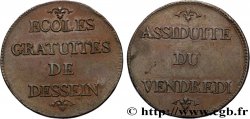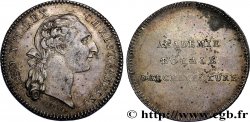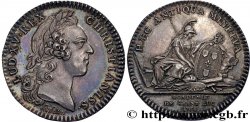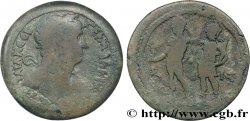fjt_946156 - ACADEMIES AND LEARNED SOCIETIES Académie royale d’Architecture n.d.
60.00 €(Approx. 70.20$ | 51.60£)
Quantity
Add to your cart

Type : Académie royale d’Architecture
Date: n.d.
Metal : silver
Diameter : 31 mm
Orientation dies : 6 h.
Weight : 7,63 g.
Rarity : R1
Catalogue references :
Obverse
Obverse legend : LUDOV. XVI. REX. CHRISTIANISS.
Obverse description : Buste à gauche de Louis XVI signé J.P.DROZ.F. [n° 380].
Obverse translation : Louis XVI, roi très chrétien.
Reverse
Reverse legend : ACADÉMIE ROYALE D'ARCHITECTURE EN TROIS LIGNES DANS LE CHAMP.
Commentary
Fondée en 1671, à l'initiative de Colbert, l'Académie d'architecture est la dernière académie royale créée. Elle siège d'abord au Louvre, puis, à partir de 1692, au Palais-Royal. Elle réunit les plus qualifiés des architectes du Roi, qui ont pour missions de jouer un rôle de conseil et d'expertise auprès de l'administration des bâtiments, de définir les règles de la "belle architecture", et de former un séminaire de jeunes architectes. En 1676, le titre d'architecte du Roi se trouve réservé aux seuls membres de l'Académie, ce qui achève de distinguer les architectes des maîtres-maçons. Quelques grands noms : Bruand, Le Pautre, Le Vau.
Founded in 1671, at the initiative of Colbert, the Academy of Architecture was the last royal academy to be created. It was first located in the Louvre, then, from 1692, in the Palais-Royal. It brought together the most qualified of the King's architects, whose missions were to play an advisory and expert role to the building administration, to define the rules of \\\"beautiful architecture\\\", and to train a seminary of young architects. In 1676, the title of architect of the King was reserved only for members of the Academy, which finally distinguished architects from master masons. Some great names: Bruand, Le Pautre, Le Vau
Founded in 1671, at the initiative of Colbert, the Academy of Architecture was the last royal academy to be created. It was first located in the Louvre, then, from 1692, in the Palais-Royal. It brought together the most qualified of the King's architects, whose missions were to play an advisory and expert role to the building administration, to define the rules of \\\"beautiful architecture\\\", and to train a seminary of young architects. In 1676, the title of architect of the King was reserved only for members of the Academy, which finally distinguished architects from master masons. Some great names: Bruand, Le Pautre, Le Vau








 Report a mistake
Report a mistake Print the page
Print the page Share my selection
Share my selection Ask a question
Ask a question Consign / sell
Consign / sell
 Full data
Full data










